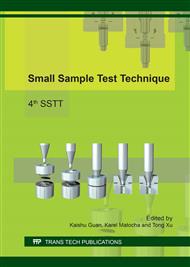[1]
M. Raynaud, A view of the European plastic pipes market in a global scenario. In: Proc. plast. pipes XII. Milan, 2004, pp.19-22.
Google Scholar
[2]
A.J. Whelton, AM Dietrich. Critical considerations for the accelerated ageing of high-density polyethylene potable water materials, Polymer Degradation and Stability. 94 (2009) 1163-1175.
DOI: 10.1016/j.polymdegradstab.2009.03.013
Google Scholar
[3]
A.M. Dietrich, AJ Whelton, D.L. Gallagher, J. Tang, Polar and non-polar contaminant transport in new and chlorine aged polyethylene pipes. Project 4138. Denver, CO: Water Research Foundation; 2010. 131.
Google Scholar
[4]
P. Gijsman, G. Meijers, G. Vitarelli, Comparison of the UV-degradation Chemistry of Polypropylene, Polyethylene, Polyamide 6 and Polybutylene Terephthalate, Polymer Degradation Stability. 65 (1999) 433-441.
DOI: 10.1016/s0141-3910(99)00033-6
Google Scholar
[5]
C.M. Liauw, A. Quadir, N.S. Allen et al, Effect of hindered piperidine light stabilizer molecular structure and UV-absorber addition on the oxidation of HDPE. Part 1: Long-term thermal and photo-oxidation studies, Journal of Vinyl and Additive Technology. 10 (2004).
DOI: 10.1002/vnl.20011
Google Scholar
[6]
F.J. Medel, F. Garcia-Àlvarez, E. Gómez-Barrena et al, Microstructure changes of extruded ultra high molecular weight polyethylene after gamma irradiation and shelf-aging, Polymer Degradation and Stability. 88 (2005) 435-443.
DOI: 10.1016/j.polymdegradstab.2004.11.015
Google Scholar
[7]
A. Amin, L. Wang, H. Yu, J. Gao, Polymer Plastics Technology and Engineering, Marcel Dekker. 49 (1973) 1594-1599.
Google Scholar
[8]
I. Kriston, E. Földes, P. Staniek, et al, Dominating reactions in the degradation of HDPE during long term ageing in water, Polymer Degradation and Stability. 93 (2008) 1715-1722.
DOI: 10.1016/j.polymdegradstab.2008.06.006
Google Scholar
[9]
M.H. Chen, J.H. Yin, W.B. Bu, Microstructure changes of polyimide/ MMT-AlN composite hybrid films under corona aging, Applied Surface Science. 26 (2012) 302-306.
DOI: 10.1016/j.apsusc.2012.09.048
Google Scholar
[10]
M.R. Davidson, S.A. Mitchell, R.H. Bradley, Surface studies of low molecular weight photolysis products from UV-ozone oxidised polystyrene, Surface Science. 581 (2005) 169-177.
DOI: 10.1016/j.susc.2005.02.049
Google Scholar
[11]
V.L. Giddings, S.M. Kurtz, C.W. Jewett, et al, A small punch test technique for characterizing the elastic modulus and fracture behavior of PMMA bone cement used in total joint replacement. Biomaterials. 22 (2001) 1875-1881.
DOI: 10.1016/s0142-9612(00)00372-0
Google Scholar
[12]
D.J. Jaekel, D.W. MacDonald, S.M. Kurtz, Characterization of PEEK biomaterials using the small punch test, Journal of the Mechanical Behavior of Biomedical Materials. 4 (2011) 1275-1282.
DOI: 10.1016/j.jmbbm.2011.04.014
Google Scholar
[13]
C. Rodríguez, D. Arencón, J. Belzunce, M.L. Maspoch. Small punch test on the analysis of fracture behaviour of PLA-nanocomposite films, Polymer Testing. 33 (2014) 21–29.
DOI: 10.1016/j.polymertesting.2013.10.013
Google Scholar
[14]
A. Ivakovic, K.C. Pandya, J.G. Williams, Crack growth predictions in polyethylene using measured traction-separation curves, Engineering Fracture Mechanics. 71 (2004) 657-668.
DOI: 10.1016/s0013-7944(03)00030-4
Google Scholar
[15]
P.S. Leevers, Interpreting instrumented three point bend fracture tests on craze forming polymers, Plastics Rubber and Composites. 29 (2000) 453-459.
DOI: 10.1179/146580100101541292
Google Scholar
[16]
B.H. Choi, A. Chudnovsky, R. Paradkar, Experimental and theoretical investigation of stress corrosion crack (SCC) growth of polyethylene pipes, Polymer Degradation and Stability. 94 (2009) 859-867.
DOI: 10.1016/j.polymdegradstab.2009.01.016
Google Scholar
[17]
D.C. Watts, Reaction kinetics and mechanics in photo-polymerised networks, Dental Materials Official Publication of the Academy of Dental Merials. 21 (2005) 27-35.
DOI: 10.1016/j.dental.2004.10.003
Google Scholar
[18]
B. Fady, R. Abdelaal, K. Rowe, Effect of high temperatures on antioxidant depletion from different HDPE geomembranes, Geotextiles and Geomembranes. 42 (2014) 284-301.
DOI: 10.1016/j.geotexmem.2014.05.002
Google Scholar
[19]
G.W. Ehrenstein, S. Pongratz, Resistance and Stability of Polymers Part 1: Principles of Aging, Carl Hanser Verlag, 2013. Reference to a chapter in an edited book, 2013: I, III–V, VII–XXIII.
Google Scholar
[20]
P. Gijsman, J. Hennekens, K. Janssen. Comparison of UV degradation chemistry in accelerated (xenon) aging tests and outdoor tests (II), Polymer Degradation and Stability. 46 (1994) 63-74.
DOI: 10.1016/0141-3910(94)90110-4
Google Scholar


